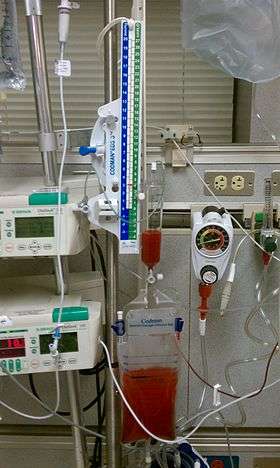External ventricular drain
| External ventricular drain | |
|---|---|
| Intervention | |
 Drainage system showing bloody CSF due to intracranial hemorrhage. |
External ventricular drain (EVD), also known as an extraventricular drain or ventriculostomy, is a device used in neurosurgery that relieves elevated intracranial pressure and hydrocephalus when the normal flow of cerebrospinal fluid around the brain is obstructed. This is a plastic tube placed by neurosurgeons and managed by ICU nurses and critical care paramedics to drain fluid from the ventricles of the brain and thus keep them decompressed, as well as to monitor intracranial pressure. An EVD should never be placed when a neurosurgeon isn't readily available, because immediate neurosurgical intervention will be needed if an unforeseen extraaxial bleed occurs, or if a major vessel is perforated.
An EVD, which is a short-term drain of hydrocephalic fluid, can be converted to a cerebral shunt, which is a long-term drain, if the person needs long-term drainage.[1]
Kocher's point
The tube is most frequently placed in Kocher's point with the goal of having the catheter tip in the frontal horn of a lateral ventricle. The catheter is normally inserted on the right side of the brain. An EVD (also called an intraventricular catheter, or IVC) is used to monitor pressure in patients with brain injuries, intracranial bleeds or other brain abnormalities that lead to increased fluid build-up. In draining the ventricle it can also remove blood from the ventricular spaces. This is important because blood is an irritant to brain tissue and can cause complications such as vasospasm.
Ongoing care
The external ventricular drain (EVD) is leveled to a common reference point, usually the tragus. The external ventricular drain is set on a graduated burette the pressure level of the EVD is prescribed by a healthcare professional, usually a neurosurgeon. Leveling the EVD to a set pressure level is the basis for cerebrospinal fluid (CSF) drainage; hydrostatic pressure dictates CSF drainage. The fluid column pressure must be greater than the weight of the CSF in the system before drainage occurs. It is important that family members and visitors understand the patient's head of bed position cannot be changed without assistance.[2]
An example of a healthcare provider order regarding an EVD is: Level external ventricular drain to 15 cmH20 above midbrain, open to drain continuously, check and record cerebrospinal fluid drainage and intracranial pressure every hour.
The cerebral perfusion pressure (CPP) can be calculated from data obtained from the EVD and systemic blood pressure. In order to calculate the CPP the intracranial pressure and mean arterial pressure (MAP) must be available.[2]
Complications
EVD is an invasive procedure. It is associated with several complications categorised as below:-
Bleeding
Commonly occurs along the EVD insertion tract or in the several layers of the meninges that prohibit passage into the brain. If drilling or dural puncture is not successful, you may dissect away dura and create a secondary bleed known as an epidural or subdural hemorrhage. This situation can be life-threatening, and requires neurosurgical care. The most dreaded bleeding complication is the realistic possibility of passing a catheter through a major aberrant vessel or existing aneurysm. If this happens, the likelihood of death is significantly increased, and may be immediate. The risk of hemorrhage is increased if the patient is having coagulopathy.
Mechanical
It can be sub-classified into:-
- Obstruction
Obstruction/occlusion of EVD commonly due to fibrinous/clot like material or kinking of the tube. The brain can swell due to pressure build up in the ventricles and permanent brain damage can occur. Physicians, nurses, and Critical Care Paramedics often have to adjust or flush these small diameter catheters to manage medical tube obstructions and occlusions at the intensive-care bedside.[3] Pressure settings are generally measured in cmH2O. The equilibrium pressure of the EVD apparatus is adjusted based on cerebrospinal fluid output, ICP waveform, imaging including CT or MRI of the brain, and clinical response.
- Migration
During the EVD insertion, the EVD is tunneled subcutaneously and anchored with suture. However, it is common for the EVD to dislodge or migrate. This will cause the tip of the drain migrated away from its supposed position and provides inaccurate ICP measurement or total occlusion of the drain.
- Infection
EVD is a foreign body inserted into human body. It can serve as an object for bacterial attachment and cause ascending infection.
Neurological
Although not many neurological deficit has been reported, Chai et al. has reported an association of patient's coma and his EVD malplacement. In his report, the EVD was inserted too deep into the Fourth ventricle. The authors hypothesised that the patient's coma was due to the EVD irritation to his Recticular Activation System. The patient's consciousness improved after the EVD was adjusted.[4]
References
- ↑ Rammos, S; et al. (2008), "Conversion of external ventricular drains to ventriculoperitoneal shunts after aneurysmal subarachnoid hemorrhage: effects of site and protein/red blood cell counts on shunt infection and malfunction", J Neurosurg, 109 (6): 1001–1004, doi:10.3171/JNS.2008.109.12.1001, PMID 19035711.
- 1 2 "Care of the Patient Undergoing Intracranial Pressure Monitoring/ External Ventricular Drainage or Lumbar Drainage". AANN Clinical Practice Guideline Series. American Association of Neuroscience Nurses.
- ↑ Kakarla UK, Kim LJ, Chang SW, Theodore N, Spetzler RF (2008). "Safety and accuracy of bedside external ventricular drain placement.". Neurosurgery. 63 (1 Suppl 1): ONS162–6; discussion ONS166–7. doi:10.1227/01.neu.0000335031.23521.d0. PMID 18728595.
- ↑ Chai FY, Farizal F, Jegan T (2013). "Coma due to malplaced external ventricular drain.". Turkish Neurosurgery. 23 (4): 561–563. doi:10.5137/1019-5149.JTN.5724-12.1. PMID 24101284.